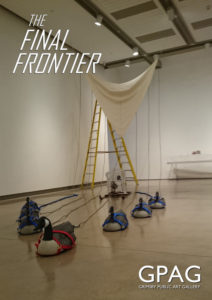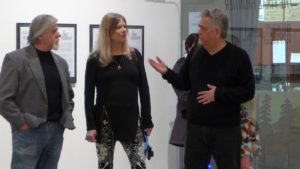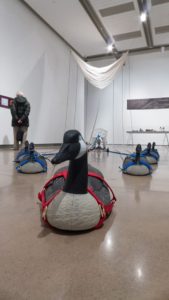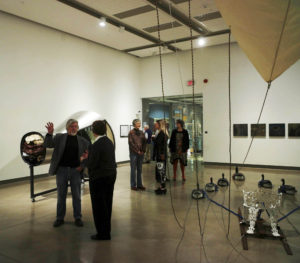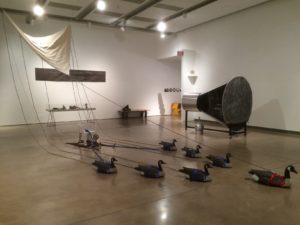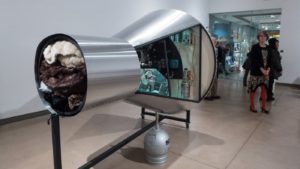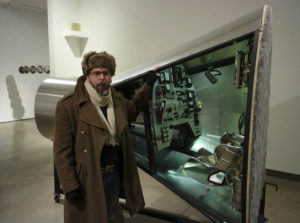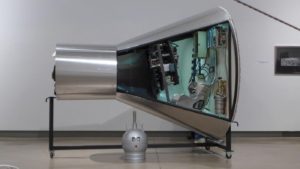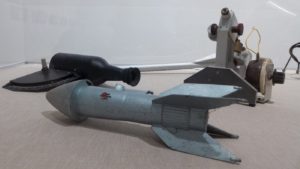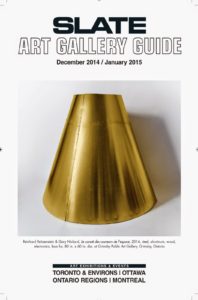FINAL FRONIER with Reinhard Reitzenstein & Patty Wallace, Grimsby Public Art Gallery, Grimsby Ontario, Canada, December 13, 2014 – February 1, 2015
“The surface of the Earth is the shore of the cosmic ocean. On this shore, we have learned most of what we know. Recently we have waded our way out, maybe ankle deep, and the water seems inviting.” – Carl Sagan, 1980
We have been looking at the night skies for thousands of years, we have used the stars to navigate by, to work out our calendars and even to try and predict the future. Humankind has for millennia wondered exactly what is out there. When Galileo pointed his telescope at Jupiter in 1610 and discovered four moons orbiting this huge planet he proved to those with open minds in his superstitious era that ours was not the only world in space.
This latest in collaborative exhibitions by Nickard, Reitzenstein & Wallace, takes a fanciful look at how human beings have tried to breach the ‘final frontier’ by attempting to travel in space, and in the immortal words of Captain James T. Kirk, to endeavor “to explore strange new worlds, to seek out new life and new civilizations, to boldly go where no man has gone before.” In that this is a Canadian exhibition, the artists envision an Anlgo/French dimension to the project.
The first group of work featured in Final Frontier is based upon a treatise by the English Puritan Dr. John Wilkins’ entitled The Discovery of a World in the Moone (1653). This book proposed (and illustrated) a flying vehicle carried aloft by geese. Combined with Patty Wallace’s naturalistic paintings of lunar craters and bird nests, the “celestial chariot” and associated artifacts are a meditation upon belief and world view, an opportunity to contemplate an intellectual adventure, no less compelling for being impossible to complete.
From our perspective today Wilkins’s effort at spaceflight may seem ludicrous, but he was the principal founder of England’s Royal Society and lived in a period marked by the astronomical revelations of Galileo, Copernicus and Kepler; the discovery of new continents, and the great sea voyages of Francis Drake and Walter Raleigh. His sense of adventure was palpable in his writing and both Wilkins and his brother-in-law Cromwell were quite serious about science and about this proposed venture to the moon.
The second group of work featured in Final Frontier is a conflation of 1920’s and1960’s ideas of a spaceship capable of reaching Mars. For a time in the late 19th and early 20th centuries, it was erroneously believed that there were canals on Mars, a network of long straight lines, first described by the Italian astronomer Schiaparelli in 1877. While always controversial, this idea was supported by later observers some of whom proposed the idea that these lines were irrigation canals built by a supposed intelligent civilization inhabiting Mars. The most ardent proponent of this notion was Percival Lowell a wealthy American amateur astronomer. Lowell published his views in three books: Mars (1895), Mars and Its Canals (1906), and Mars As the Abode of Life (1908). With these writings, Lowell more than anyone else popularized the long-held belief that these markings showed that Mars was home to a civilization capable of engineering thousands of miles of canals.
“There are celestial sights more dazzling, spectacles that inspire more awe,
but to the thoughtful observer who is privileged to see them well, there is nothing in the sky so profoundly impressive as the canals of Mars” – Percival Lowell (1908)
While eventually disproved, Lowell’s vision of the Martian canals, as an artifact of an ancient civilization making a desperate last effort to survive, significantly influenced the development of science fiction – starting with H. G. Wells influential The War of the Worlds wherein creatures from an increasingly arid Mars sought to invade Earth in order to survive. This image of the dying Mars and its ancient culture was retained, even when proven to be untrue, in a great deal of 20th century science fiction. For example, the canals figure prominently in Red Planet by Robert A. Heinlein (1949) and The Martian Chronicles by Ray Bradbury (1950).
In recognition of the initial exploration of Canada by Coureurs des bois, the Mars spaceship will be a French Canadian venture to trap beaver along the canals and to trade with the indigenous first peoples of the Red Planet. The term “Coureurs des bois” is most strongly associated with those who engaged in the fur trade in ways that circumvented the normal channels of authority by going ever deeper into the wilderness. They were a kind of outlaw entrepreneur and frequently offered better terms to the natives than the Ancien Regime sanctioned Voyageurs. Accordingly Nickard, Reitzenstein & Wallace constructed an outlaw spacecraft, entirely fanciful in its confusion of plausible and implausible – just the thing for 3 latter day Coureurs to fly to Mars!
